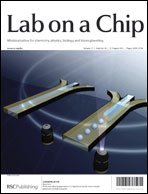 The image on the outside front cover of Issue 16 shows the method developed by Damien Baigl, Ecole Normale Superieure, Paris, and colleagues to reversibly switch from a continuous two-phase laminar flow to a droplet generating regime in microfluidic chips. They have achieved this by incorporating a photosensitive surfactant into the aqueous phase.
The image on the outside front cover of Issue 16 shows the method developed by Damien Baigl, Ecole Normale Superieure, Paris, and colleagues to reversibly switch from a continuous two-phase laminar flow to a droplet generating regime in microfluidic chips. They have achieved this by incorporating a photosensitive surfactant into the aqueous phase.
Photoreversible fragmentation of a liquid interface for micro-droplet generation by light actuation
Antoine Diguet, Hao Li, Nicolas Queyriaux, Yong Chen and Damien Baigl
Lab Chip, 2011, 11, 2666-2669
 On the inside front cover we have μFlowFISH – an integrated microfluidic device capable of performing 16S rRNA fluorescence in situ hybridization with flow cytometric detection for identifying bacteria. The device developed by Anup K. Singh, Sandia National Laboratories and colleagues at Lawrence Berkeley National Laboratories was tested in a highly contaminated site using species involved in Cr(VI) remediation and was proved capable of quantitative detection of low numbers of microbial cells from complex samples.
On the inside front cover we have μFlowFISH – an integrated microfluidic device capable of performing 16S rRNA fluorescence in situ hybridization with flow cytometric detection for identifying bacteria. The device developed by Anup K. Singh, Sandia National Laboratories and colleagues at Lawrence Berkeley National Laboratories was tested in a highly contaminated site using species involved in Cr(VI) remediation and was proved capable of quantitative detection of low numbers of microbial cells from complex samples.
Microfluidic fluorescence in situ hybridization and flow cytometry (μFlowFISH)
Peng Liu, Robert J. Meagher, Yooli K. Light, Suzan Yilmaz, Romy Chakraborty, Adam P. Arkin, Terry C. Hazen and Anup K. Singh
Lab Chip, 2011, 11, 2673-2679
View the rest of the issue, which includes the first in the series of Research Highlight articles from Ali Khademhosseini, reviewing the current literature in miniaturisation and related technologies, a Critical Review from Daniel T. Chiu on transitioning disposable microfluidic substrates from the lab into the clinic and a Focus article from Helene Andersson Svahn on massively parallel sequencing platforms.










